Dynamics of coronavirus replication-transcription complexes
- PMID: 20007278
- PMCID: PMC2812403
- DOI: 10.1128/JVI.01716-09
Dynamics of coronavirus replication-transcription complexes
Abstract
Coronaviruses induce in infected cells the formation of double-membrane vesicles (DMVs) in which the replication-transcription complexes (RTCs) are anchored. To study the dynamics of these coronavirus replicative structures, we generated recombinant murine hepatitis coronaviruses that express tagged versions of the nonstructural protein nsp2. We demonstrated by using immunofluorescence assays and electron microscopy that this protein is recruited to the DMV-anchored RTCs, for which its C terminus is essential. Live-cell imaging of infected cells demonstrated that small nsp2-positive structures move through the cytoplasm in a microtubule-dependent manner. In contrast, large fluorescent structures are rather immobile. Microtubule-mediated transport of DMVs, however, is not required for efficient replication. Biochemical analyses indicated that the nsp2 protein is associated with the cytoplasmic side of the DMVs. Yet, no recovery of fluorescence was observed when (part of) the nsp2-positive foci were bleached. This result was confirmed by the observation that preexisting RTCs did not exchange fluorescence after fusion of cells expressing either a green or a red fluorescent nsp2. Apparently, nsp2, once recruited to the RTCs, is not exchanged with nsp2 present in the cytoplasm or at other DMVs. Our data show a remarkable resemblance to results obtained recently by others with hepatitis C virus. The observations point to intriguing and as yet unrecognized similarities between the RTC dynamics of different plus-strand RNA viruses.
Figures
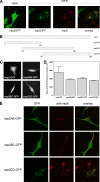
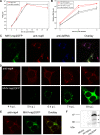
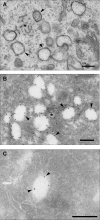


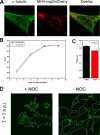
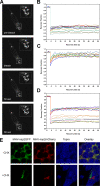
Similar articles
-
Competitive fitness in coronaviruses is not correlated with size or number of double-membrane vesicles under reduced-temperature growth conditions.mBio. 2014 Apr 1;5(2):e01107-13. doi: 10.1128/mBio.01107-13. mBio. 2014. PMID: 24692638 Free PMC article.
-
Expression and Cleavage of Middle East Respiratory Syndrome Coronavirus nsp3-4 Polyprotein Induce the Formation of Double-Membrane Vesicles That Mimic Those Associated with Coronaviral RNA Replication.mBio. 2017 Nov 21;8(6):e01658-17. doi: 10.1128/mBio.01658-17. mBio. 2017. PMID: 29162711 Free PMC article.
-
The nsp2 replicase proteins of murine hepatitis virus and severe acute respiratory syndrome coronavirus are dispensable for viral replication.J Virol. 2005 Nov;79(21):13399-411. doi: 10.1128/JVI.79.21.13399-13411.2005. J Virol. 2005. PMID: 16227261 Free PMC article.
-
Biogenesis and architecture of arterivirus replication organelles.Virus Res. 2016 Jul 15;220:70-90. doi: 10.1016/j.virusres.2016.04.001. Epub 2016 Apr 9. Virus Res. 2016. PMID: 27071852 Free PMC article. Review.
-
The double-membrane vesicle (DMV): a virus-induced organelle dedicated to the replication of SARS-CoV-2 and other positive-sense single-stranded RNA viruses.Cell Mol Life Sci. 2022 Jul 16;79(8):425. doi: 10.1007/s00018-022-04469-x. Cell Mol Life Sci. 2022. PMID: 35841484 Free PMC article. Review.
Cited by
-
Global siRNA Screen Reveals Critical Human Host Factors of SARS-CoV-2 Multicycle Replication.bioRxiv [Preprint]. 2024 Jul 10:2024.07.10.602835. doi: 10.1101/2024.07.10.602835. bioRxiv. 2024. Update in: PLoS Biol. 2025 Jun 12;23(6):e3002738. doi: 10.1371/journal.pbio.3002738. PMID: 39026801 Free PMC article. Updated. Preprint.
-
Mechanisms of Cellular Membrane Reorganization to Support Hepatitis C Virus Replication.Viruses. 2016 May 20;8(5):142. doi: 10.3390/v8050142. Viruses. 2016. PMID: 27213428 Free PMC article. Review.
-
Membrane rearrangements mediated by coronavirus nonstructural proteins 3 and 4.Virology. 2014 Jun;458-459:125-35. doi: 10.1016/j.virol.2014.04.027. Epub 2014 May 13. Virology. 2014. PMID: 24928045 Free PMC article.
-
Coronavirus envelope (E) protein remains at the site of assembly.Virology. 2015 Apr;478:75-85. doi: 10.1016/j.virol.2015.02.005. Epub 2015 Feb 27. Virology. 2015. PMID: 25726972 Free PMC article.
-
Classification, replication, and transcription of Nidovirales.Front Microbiol. 2024 Jan 24;14:1291761. doi: 10.3389/fmicb.2023.1291761. eCollection 2023. Front Microbiol. 2024. PMID: 38328580 Free PMC article. Review.
References
-
- Beaudouin, J., D. Gerlich, N. Daigle, R. Eils, and J. Ellenberg. 2002. Nuclear envelope breakdown proceeds by microtubule-induced tearing of the lamina. Cell 108:83-96. - PubMed
-
- Bi, W., J. D. Pinon, S. Hughes, P. J. Bonilla, K. V. Holmes, S. R. Weiss, and J. L. Leibowitz. 1998. Localization of mouse hepatitis virus open reading frame 1A derived proteins. J. Neurovirol. 4:594-605. - PubMed
Publication types
MeSH terms
Substances
LinkOut - more resources
Full Text Sources

